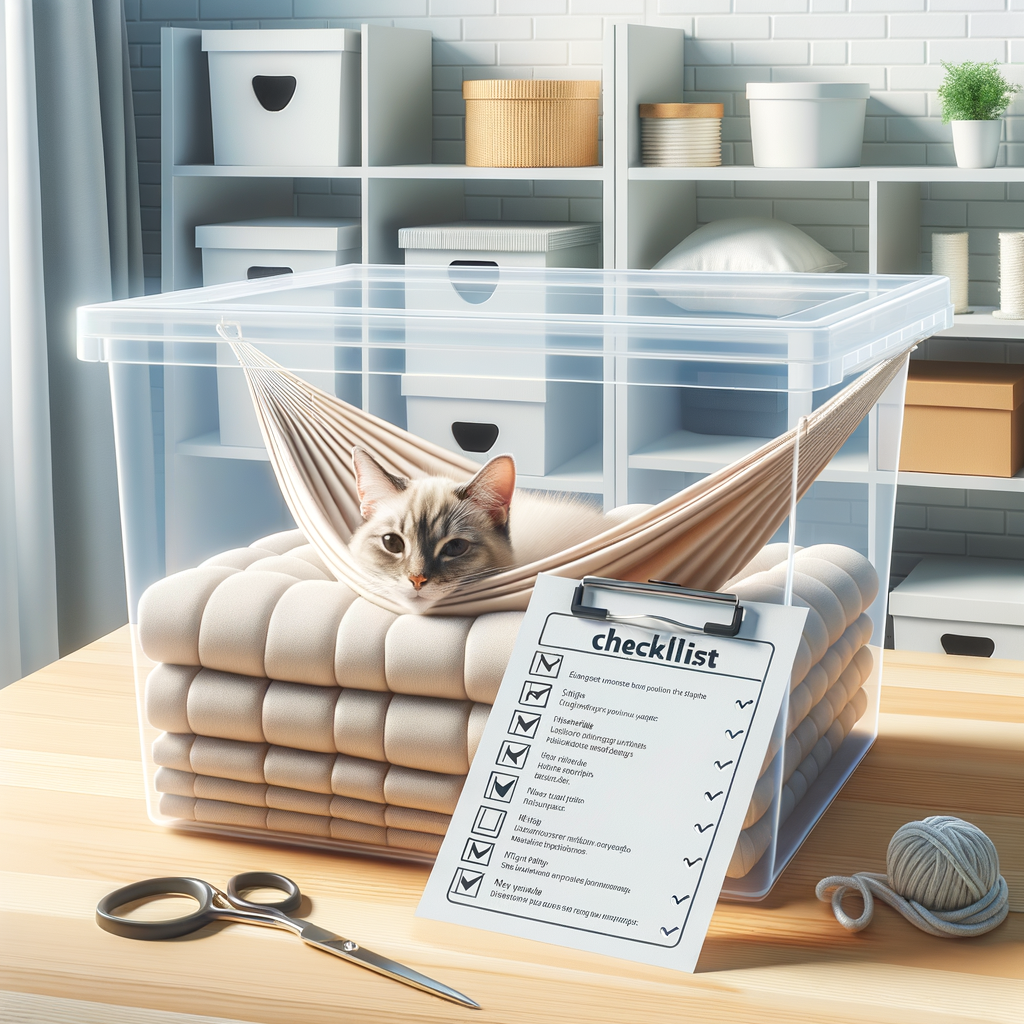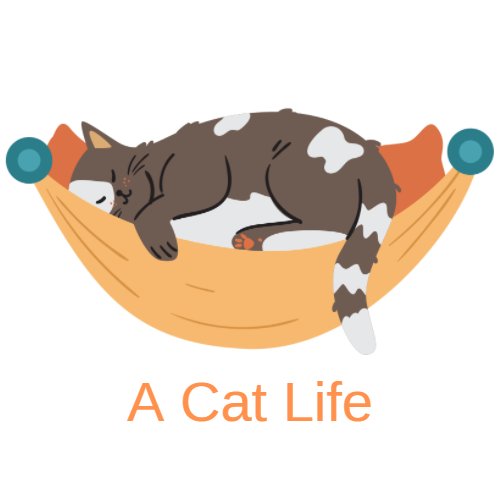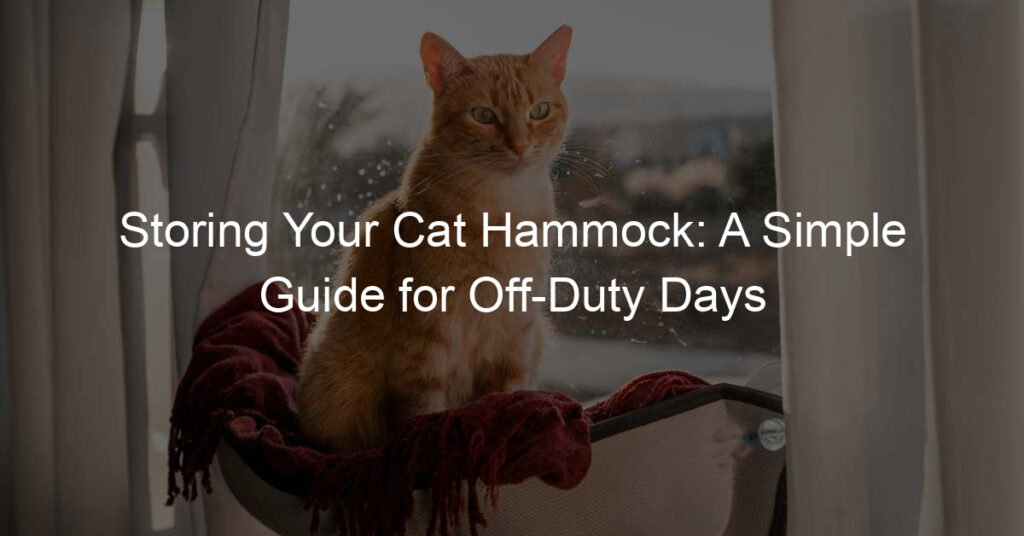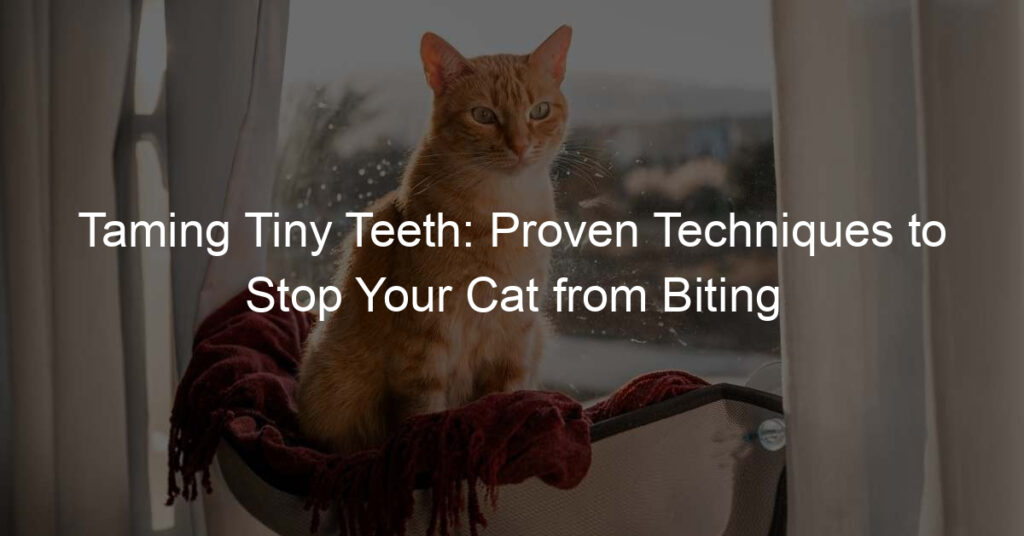
Introduction to Cat Hammock Storage
As a cat owner, you’ve likely discovered the joy that a cat hammock can bring to your feline friend. These cozy hanging beds provide a unique and comfortable place for cats to rest and observe their surroundings. However, proper storage of these hammocks is crucial to ensure their longevity and to keep your cat happy and comfortable. In this section, we’ll explore the importance of proper cat hammock storage and dispel some common misconceptions.
- The Importance of Proper Cat Hammock Storage
- Common Misconceptions about Storing Cat Hammocks
Proper storage of a cat hammock is not just about keeping your home tidy. It’s about ensuring the hammock remains in good condition, free from damage and wear. When stored correctly, a cat hammock can last for years, providing a comfortable and familiar spot for your cat to relax. Incorrect storage, on the other hand, can lead to damage such as fraying, tearing, or even mold growth if the hammock is put away damp. This not only shortens the lifespan of the hammock but can also pose health risks to your cat.
Many cat owners believe that cat hammocks can be stored in the same way as any other household item. However, this is a common misconception. Cat hammocks are made from specific materials designed to be comfortable and durable for cats, and these materials often require special care. For example, it’s a common belief that cat hammocks can be folded and stored away in any drawer or closet. In reality, folding can cause creases that damage the material over time. Instead, it’s best to roll the hammock or hang it in a dry, cool place.
In the following sections, we’ll delve deeper into understanding your cat hammock, how to store it properly, and how to preserve it to ensure your cat’s comfort and happiness. Stay tuned for more cat hammock storage tips!
Understanding Your Cat Hammock
When it comes to the comfort and happiness of your feline friend, understanding your cat hammock is crucial. This includes knowing the materials used in its construction and how they affect its care and maintenance.
Materials Used in Cat Hammocks
Cat hammocks are made from a variety of materials, each with its own unique properties. Let’s delve into the details.
- How different materials affect Cat Hammock Care
- Why material matters in Cat Hammock Maintenance
Materials used in cat hammocks can greatly influence how you care for them. For instance, hammocks made from cotton are soft, breathable, and easy to clean, making them ideal for cats that shed a lot. On the other hand, nylon hammocks are durable and water-resistant, but they may require special cleaning methods to maintain their condition.
The material of your cat hammock not only affects its care but also its maintenance. A hammock made from a durable material like canvas will last longer and require less frequent replacement than one made from a less sturdy material. Moreover, some materials may need regular treatment to prevent wear and tear, while others may be more resistant to scratches and damage from your cat’s claws.
In conclusion, understanding the materials used in your cat hammock will help you provide the best care and maintenance for it, ensuring a comfortable and safe space for your cat to relax.
Types of Cat Hammocks
There are various types of cat hammocks available in the market today. Each type has its unique features and storage requirements. Understanding these differences can help you choose the right hammock for your feline friend and ensure its longevity through proper storage.
- How Different Types Affect Storage Methods
- Choosing the Right Type for Easy Storage
Different types of cat hammocks require different storage methods. For instance, a window-mounted cat hammock, with its suction cups and support cables, requires a flat surface for storage to prevent damage to its components. On the other hand, a free-standing cat hammock, with its sturdy frame, may need more space but can be easily disassembled for compact storage.
Another type is the radiator cat hammock, which is designed to hang on the radiator. It’s made of heat-resistant materials and requires careful storage to avoid damaging these materials. Lastly, the cage or chair hanging cat hammock is typically made of soft, machine-washable fabric and can be folded for easy storage.
When choosing a cat hammock, consider your available storage space. If you have limited space, a foldable fabric hammock might be the best option. It’s easy to store and doesn’t require any special storage conditions. However, if you have ample storage space, a free-standing or window-mounted hammock could be a great choice as they offer more comfort and viewing pleasure for your cat.
Remember, proper storage of your cat’s hammock not only prolongs its life but also ensures your cat’s safety and comfort. Always refer to the manufacturer’s storage instructions to keep your cat hammock in the best condition.
In conclusion, understanding the different types of cat hammocks and their storage requirements can help you make an informed choice. Whether you choose a window-mounted, free-standing, radiator, or chair hanging hammock, ensure it suits your cat’s preferences and your storage capabilities.
How to Store Cat Hammocks
Storing your cat hammock properly is essential to maintain its longevity and ensure your feline friend can enjoy it for years to come. The first step in the storage process is preparing the hammock for storage. This involves two main steps: cleaning the hammock and checking for any damage or wear.
Preparation for Storage
Before you store your cat hammock, it’s important to prepare it correctly. This will help to keep it in the best condition possible, ready for use when you need it again.
- Cleaning your Cat Hammock before storage
- Checking for damage and wear
Cleaning your cat hammock before storing it is a crucial step. This will remove any dirt, fur, or other debris that could cause damage over time. Use a mild detergent and warm water to gently clean the hammock. Make sure to rinse thoroughly and allow it to dry completely before storing to prevent mold and mildew.
Before storing your cat hammock, give it a good once-over for any signs of damage or wear. Look for any tears, fraying, or loose threads. If you find any, it’s best to repair them before storage. This will prevent the damage from getting worse and ensure the hammock is ready to use when you need it again.
Properly preparing your cat hammock for storage can help to extend its life and keep your cat comfortable and happy. Remember, a clean and well-maintained hammock is a happy hammock!
Storage Methods
When it comes to storing your cat hammock, there are several methods you can use. These include proper folding techniques, using cat hammock storage solutions, and even creating your own DIY storage ideas. Let’s delve into these methods.
- Proper Folding Techniques for Cat Hammocks
- First, lay the hammock flat on a clean surface.
- Next, fold it in half lengthwise, ensuring the hooks or attachments are on the outside.
- Then, fold it in half again, this time widthwise.
- Finally, roll it up tightly from one end to the other, securing it with a rubber band or string.
- Using Cat Hammock Storage Solutions
- DIY Cat Hammock Storage Ideas
Folding your cat hammock correctly is crucial for maintaining its shape and durability. Here’s a simple step-by-step guide:
This method will help keep your cat hammock compact and prevent any damage during storage.
There are many storage solutions available specifically for cat hammocks. These include storage bags, boxes, and even specially designed hangers. These solutions not only protect your hammock from dust and damage but also make it easy to find when you need it.
For instance, a storage bag with a clear window allows you to see the hammock inside without having to open it. On the other hand, a storage box can be stacked, saving you space.
If you’re feeling creative, you can also create your own storage solutions. For example, you could repurpose an old suitcase or a shoebox. Just make sure whatever you use is clean and dry to prevent any mold or mildew.
Another DIY idea is to use a coat hanger. Simply fold your hammock as described above, then slip it over the hanger. This allows you to hang it in a closet or on a rack, keeping it off the ground and out of the way.
Regardless of the method you choose, remember that the key to successful cat hammock storage is to keep it clean, dry, and free from damage. This way, your feline friend will always have a comfortable place to relax.
Preserving Your Cat Hammock
Preserving your cat hammock is essential for its longevity. It’s not just about storing it away; it’s about taking the right steps to ensure it remains in good condition for your feline friend. In this section, we will discuss how to prevent damage during storage.
Preventing Damage During Storage
When it comes to storing your cat hammock, there are two key areas to focus on: proper storage to prevent physical damage, and protection from pests. Let’s delve into these areas.
- Proper Storage for Cat Hammock to Prevent Damage
- Protecting Your Cat Hammock from Pests
Storing your cat hammock properly is the first step to preserving it. Avoid folding it in a way that could cause creases or tears. Instead, roll it up gently and place it in a breathable fabric bag. This allows air to circulate, preventing mold and mildew. Also, store it in a cool, dry place away from direct sunlight to prevent color fading and material degradation.
Another important aspect of preserving your cat hammock is protecting it from pests. Insects and rodents can cause significant damage. To keep them at bay, consider using a cedar block or sachet in the storage area. Cedar naturally repels many types of pests and will not harm your cat. However, avoid using mothballs as they can be toxic to cats.
By following these guidelines, you can ensure your cat hammock remains in top condition during storage, ready for your cat to enjoy when you bring it out again.
Long-term Cat Hammock Care
Ensuring the longevity of your cat hammock requires regular maintenance and knowing when it’s time for a replacement. Let’s delve into these aspects in more detail.
- Regular maintenance tips for Cat Hammocks
- Cleaning: Regular cleaning is crucial. Most cat hammocks can be machine washed. However, always check the care label before washing.
- Inspection: Regularly inspect your cat hammock for any signs of wear and tear. Look out for loose threads, fraying edges, and any other potential hazards.
- Rotation: If you have more than one cat hammock, rotate them regularly. This can help to evenly distribute wear and tear, extending the lifespan of each hammock.
- When to replace your Cat Hammock
- Excessive Wear and Tear: If your cat hammock shows signs of excessive wear, such as torn fabric or a broken frame, it’s time for a replacement.
- Discomfort: If your cat seems uncomfortable or avoids the hammock, it might be because it’s no longer comfortable. A new hammock might be just what your cat needs.
- Age: If your cat hammock is several years old, it might be time for a new one, even if it doesn’t show obvious signs of wear. Over time, the materials can become less comfortable and supportive.
Just like any other pet accessory, cat hammocks need regular care to remain in top shape. Here are some simple tips to help you maintain your cat hammock:
Knowing when to replace your cat hammock is just as important as maintaining it. Here are some signs that it might be time for a new one:
In conclusion, taking care of your cat hammock involves regular cleaning, inspection, and rotation. And remember, when it shows signs of excessive wear, discomfort to your cat, or has simply aged, it’s time for a replacement. Your cat will thank you for it!
Conclusion: Cat Hammock Storage Tips for a Happy Cat
As we wrap up our discussion on cat hammock storage, it’s important to remember that the happiness and comfort of your feline friend are paramount. The way you store and care for your cat’s hammock can significantly impact its longevity and your cat’s overall well-being.
- Recap of key Cat Hammock Storage Solutions
- Final thoughts on the importance of proper Cat Hammock Care
Throughout this article, we’ve explored several key storage solutions for cat hammocks. We learned that it’s essential to clean the hammock regularly and ensure it’s thoroughly dry before storing. We also discussed the importance of storing the hammock in a cool, dry place to prevent mold and mildew. Furthermore, we highlighted the need to avoid folding the hammock too tightly to prevent damage to its structure.
Proper care of your cat’s hammock is not just about prolonging its lifespan, but it’s also about ensuring the comfort and happiness of your feline friend. A well-cared-for hammock is more comfortable and safer for your cat, contributing to their overall well-being. Remember, a happy cat is a healthy cat!
In conclusion, the care and storage of your cat’s hammock should not be taken lightly. It’s a small investment that can yield significant benefits for your cat’s comfort and happiness. So, let’s make the most of these tips and ensure our feline friends have a cozy and well-maintained hammock to enjoy!








